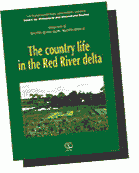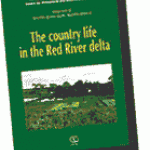A Book of Rural Vietnam: Country Life in the Red River Delta
Most visitors to Vietnam spend time in Hanoi, epicenter of the Red River Delta. Far fewer visitors venture outside the city and into the surrounding countryside of the delta where eighty percent of the region's people live in relatively traditional and agrarian communities. To experience the Red River Delta fully, one should explore the rice paddies and villages that are the bedrock of this remarkable region.
Country Life in the Red River Delta (The Gioi, 1997) provides an in-depth overview of the area and is a useful reference for those with an interest in the delta. The 122-page softcover book is broken into text and photo sections covering all aspects of rural life. More encyclopedia than guidebook, the book strives to introduce foreign readers and visitors to the Red River Delta. The people consider this region to be the cultural and historical heartland of their nation, not to mention its breadbasket and political center.
Where Black Tigers and Wild Elephants Once Roamed
On the very first pages of the book, the authors explain that the Red River Delta is one of the two largest deltas in the country, the other being the Mekong River's in the south. The Red River Delta began to take its present form a mere 4,000 years ago--a microsecond in geologic time--when silt began to collect at the mouths of the Red and Thai Binh Rivers. The process continues today and in an example of the often astonishing details that pepper the book, the authors note that in some spots, the coast extends by an astonishing 100 meters a year. Today some fifteen million people inhabit the region, which is one of the highest population densities in the world.
Somewhat wistfully, the authors note that the delta has lost virtually all of its wild space. Over centuries, the entire area has been painstakingly and laboriously sculpted by man into a patchwork of rice paddies bordered by dikes and crisscrossed by canals. The authors explain how dense wilderness once covered the delta and that in the eleventh century, King Ly went elephant hunting near what is now Hanoi's West Lake. As late as the Tran Dynasty (1226-1400), black tigers still roamed the capital, but today the only hints of the delta's former wilderness appear in geographic names. The words "lam" and "rung," which both mean "forest," frequently appear in place names. There is the Gia Lam district, for example, and the Rung village, Rung River and Rung market.
"However limpid or muddy it might be, the native village pond is the best." -- Red River Delta proverb
Country Life in the Red River Delta provides a wealth of information that will help the traveler interpret what he or she is seeing. For example, the authors explain that historically the Red River Delta supported a large number of skilled craftsmen due to the fact that the annual rice-growing cycle featured a period where farmers left the land fallow, thus freeing them to pursue other ventures. Villages specialized in a variety of crafts that ranged from the making of conical 'non' hats to the production of lacquerware and this tradition continues to the present day. Bat Trang, a community near Hanoi that specializes in ceramics, remains one of the most famous of these villages.
Much of the book is devoted to explicating the villages of the delta. The authors emphasize that life in the region has always revolved around the small agrarian communities where so much of the population lives, works and dies. The traditional village, now idealized by the Vietnamese in the same way that Americans romanticize small-town USA, typically consisted of a small community surrounded by rice paddies. A bamboo hedge and moat enclosed the village and inside this protective girdle lay the community's homes, pagodas and communal buildings. Many of the book's photographs portray these aspects of the traditional village.
"Crabs and Snails Fishing" and "New-Age Wedding"
Over a hundred color and black-and-white photos fill the second half of the book. Reproduced on roomy 8 by 11½-inch pages, these pictures comprise a fascinating photomontage that is like a traveler's slideshow. They offer a complete overview of life in the delta, picturing everything from rice planting to funerals, folk festivals to Catholic Church ceremonies. The pictures are a good source of inspiration for exploring off the beaten track, since they reveal little known but intriguing sights to visit. A good example is the roofed bridge of Quan Anh, which is their version of the New England covered bridge. The captions have their quirky moments, too. One reads "crabs and snails fishing," which does not exactly provide an accurate sense of the picture. Another photo is labeled "new-aged wedding." Rather than something involving crystals and pyramid power, however, the picture features a bride and groom in western-style gown and tuxedo.
It is clear that the authors of the book love the Red River Delta landscape and its people. However, they aren't afraid to mention the negatives. They note that gambling, drugs and "superstitious beliefs" still plague the delta. And while the free-market 'doi moi' policies of the government have brought newfound prosperity to the region, they have also eroded the positive aspects of traditional culture and led to the "unconditional pursuit of money and unsuitable lifestyles under alien influence." But the delta has always balanced old and new, foreign and Vietnamese, traditional and radical. Consequently, the authors do not doubt that the delta's unique culture will persevere and its people prosper.
Like any good reference book, Country Life in the Red River Delta caters to all interests. This book has pages for the meteorologist, the geologist, the anthropologist, the military historian, the backpacker, the tour guide and the armchair traveler. Like the delta region itself, this book truly offers something for everyone.
 ThingsAsian
ThingsAsian

















